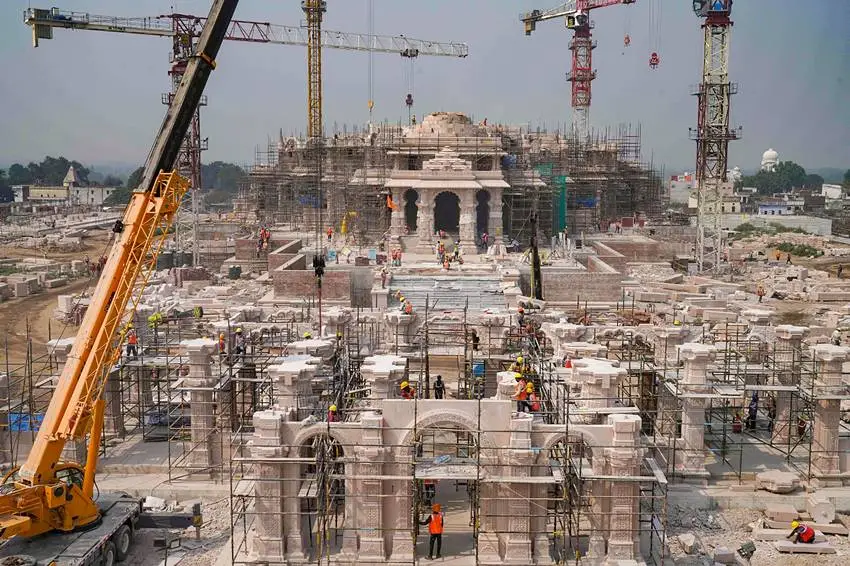The Ayodhya temple, dedicated to Lord Ram, occupies a central place in India’s socio-political and cultural landscape. This ancient site, believed to be the birthplace of the revered Hindu deity, is not only a spiritual epicenter but also a focal point of intense political discourse. The temple’s historical and religious significance has been overshadowed at times by its role in contemporary politics, particularly concerning the Ram Janmabhoomi-Babri Masjid dispute.
Table of Contents
Political Significance of the Ram Temple
The political significance of the Ayodhya temple is deeply intertwined with the events of December 6, 1992, when the Babri Masjid, a mosque built in the 16th century by Mughal emperor Babur, was demolished by a large group of Hindu nationalists. This event was a pivotal moment in Indian history, leading to widespread communal riots and fundamentally altering the country’s political landscape. The demolition and the subsequent legal and political battles over the site have become symbols of the struggle between secularism and religious nationalism in India.
The Ram Janmabhoomi movement, spearheaded by the Bharatiya Janata Party (BJP) and its allied organizations like the Rashtriya Swayamsevak Sangh (RSS) and the Vishwa Hindu Parishad (VHP), used the Ayodhya temple issue to galvanize support. The movement framed the construction of a grand Ram temple at the disputed site as a matter of cultural and national pride. This narrative significantly contributed to the rise of the BJP, transforming it from a marginal political entity into a dominant force in Indian politics.
The Supreme Court’s landmark verdict in November 2019, which allowed the construction of the Ram temple at the disputed site, marked a significant victory for the BJP and its affiliates. This decision was hailed by supporters as a long-awaited vindication of their efforts. For the BJP, the temple project symbolizes the fulfillment of a core electoral promise and the restoration of Hindu pride. The construction of the temple has since been used to rally political support and consolidate the party’s voter base, further entrenching its ideological stance.
Recent Complaints
Amidst the grand political and religious narrative surrounding the Ayodhya temple, recent complaints by the chief priest about leaking roofs and inadequate drainage facilities have brought to light practical challenges that often get overshadowed by the larger discourse. The priest’s grievances highlight a stark contrast between the temple’s symbolic grandeur and its physical condition.
Leaking roofs and poor drainage are not merely inconveniences; they are emblematic of deeper issues related to governance and resource management. Despite the substantial funds and national attention directed towards the temple’s construction and maintenance, these infrastructural problems persist. They raise questions about the efficiency and priorities of the authorities responsible for the temple’s upkeep.
The leaking roofs pose a threat to the preservation of the temple, potentially causing water damage to the structure and the sacred artifacts housed within. Similarly, the inadequate drainage system exacerbates the risk of water-related damage, especially during the monsoon season. These issues not only compromise the temple’s structural integrity but also detract from the devotees’ experience, affecting the sanctity and cleanliness of this revered site.
Conclusion
The priest’s complaints have broader implications, reflecting on the gap between political rhetoric and administrative action. The issues highlight a recurring theme in large-scale religious and political projects in India, where symbolic gestures often overshadow practical necessities. They suggest a need for more diligent planning, execution, and ongoing maintenance to ensure that such projects are sustainable and serve their intended purpose effectively.
Moreover, these infrastructural issues provide ammunition for political opponents and critics who argue that the temple project, while politically expedient, may lack the necessary administrative foresight. They underscore the importance of addressing the actual needs of the site and its caretakers, rather than focusing solely on its symbolic value.
In conclusion, the Ayodhya temple stands as a powerful symbol of India’s complex interplay between religion and politics. Its significance extends beyond spiritual devotion, embodying the aspirations and tensions of a nation grappling with its identity. The infrastructural issues raised by the priest serve as a poignant reminder that maintaining such a revered site requires more than political will; it demands practical, effective administration to preserve its sanctity and legacy for future generations.

1 Comment
Hi i think that i saw you visited my web site thus i came to Return the favore I am attempting to find things to improve my web siteI suppose its ok to use some of your ideas